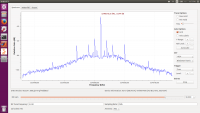
usrp-users@lists.ettus.com
Discussion and technical support related to USRP, UHD, RFNoC
View all threadsUnderstanding FFT spectrum
Hi USRP mailing list,
We have an N210 + CBX transmitter, and an X310 + TwinRX receiver. We
transmit a 10KHz tone from one to the other, on an RF carrier frequency of
5.24GHz.
When we have a wired (+attenuated) setup between the two, and look at the
FFT we see a spectrum as shown in spectrum_wired.png . Our TX setting is:
gain 5dB , tone amplitude 0.2, cosine wave, samp rate = 250e3
And, when we go wireless and ramp up the transmitted signal, we see
different "peaks" in the FFT (wireless_fft1.png). Our TX setting is : gain
25dB , tone amplitude 0.8 , cosine wave, samp rate = 2M
Could someone please explain why this might be happening ?
I read that non-linearity in the TX amplifier could cause harmonics at fc
+/- N*10Khz (fc = 5.24 GHz). Could you please confirm that this is what is
happening here ? If so, why might we be seeing harmonics even in the wired
setup ?
Furthermore, is there anyway to get rid of the effect of fc ?
Thanks in advance!
Steve
Hi Steve,
yes, nonlinearities in amplifiers would be my interpretation, too. But
I'd suspect that these might be (also) happening on the RX side – what's
your gain there? What's the attenuation?
My further approach would be:
- Get the CBX performance data from [1]
- From that, read/estimate max output power at given freq and gain (5
dB: ca -10 dBm, 25 dB: ca 10 dBm) - Estimate TX output power (5 dB -> -10dBm · 0.2 ampl: ca -24 dBm, 25
dB -> 10dBm · 0.8 ampl: ca 8 dBm) - Estimate power reaching the TwinRX (5 dB/cable: -10 dBm·attenuation;
25 dB/antennas: ca +8 dBm · antenna gain · path loss) - Compare to TwinRX third order intercepts from [2]
Let's throw in some numbers that I'd wildly guess:
- 2dB antenna gain on both ends, distance 2m -> path loss = (4πd/λ)² ~=
(25m)/(5.7·10⁻²m))² ~= 437² ~= 52dB
That'd lead to
- Wired RX power = -(54+attenuation_dB) dBm
- Wireless RX power = -44 dBm
Since we're seeing roughly the same power in both your plots, wild
guess, you're using 10dB attenuation (assuming in both cases you had the
same RX gain), OR, and that's at least as likely, my head calc wasn't
all that right.
In any case, we should be
a) pretty far away from output intercepts on the transmit side (the CBX
was designed so that IP3 is always solidly above output power),
b) pretty far away from RX input intercept points with our signals,
considering the wired signal looks "pretty clean".
That leaves me with the suspicion we're dealing with a high RX gain and
a blocking interferer that you can't see, because it's outside your 250
kHz digitally observable bandwidth, but that is still within the analog
receive bandwidth. Would that be possible to test for? Maybe just using
a much larger sampling rate than 250 kS/s receive-side with the same
center frequency?
Best regards,
Marcus
[1] https://files.ettus.com/performance_data/
[2] https://kb.ettus.com/TwinRX
On 09/28/2017 10:44 AM, Steve Gough via USRP-users wrote:
Hi USRP mailing list,
We have an N210 + CBX transmitter, and an X310 + TwinRX receiver. We
transmit a 10KHz tone from one to the other, on an RF carrier
frequency of 5.24GHz.
When we have a wired (+attenuated) setup between the two, and look at
the FFT we see a spectrum as shown in spectrum_wired.png . Our TX
setting is: gain 5dB , tone amplitude 0.2, cosine wave, samp rate = 250e3
And, when we go wireless and ramp up the transmitted signal, we see
different "peaks" in the FFT (wireless_fft1.png). Our TX setting is :
gain 25dB , tone amplitude 0.8 , cosine wave, samp rate = 2M
Could someone please explain why this might be happening ?
I read that non-linearity in the TX amplifier could cause harmonics at
fc +/- N*10Khz (fc = 5.24 GHz). Could you please confirm that this is
what is happening here ? If so, why might we be seeing harmonics even
in the wired setup ?
Furthermore, is there anyway to get rid of the effect of fc ?
Thanks in advance!
Steve
USRP-users mailing list
USRP-users@lists.ettus.com
http://lists.ettus.com/mailman/listinfo/usrp-users_lists.ettus.com


